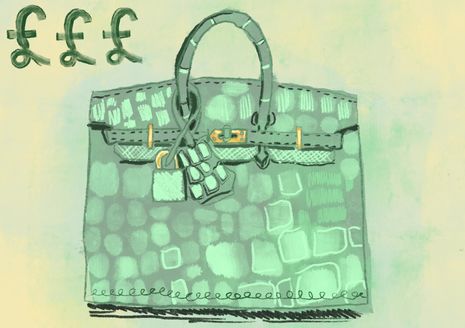Why style is the smartest investment
Niamh Walters examines why style is becoming a smart financial asset, not just a splurge

The 2000s were truly the golden age for romantic comedies: 30 Going on 30, Bridget Jones and How to Lose a Guy in 10 Days. My favourite, though, was always the perhaps underrated gem Confessions of a Shopaholic, in which Isla Fisher’s Rebecca navigates love, career … and an escalating mountain of debt caused by her fashion addiction.
While the film features witty dialogue, great chemistry between the leads and a somewhat redemptive message, it reinforces a familiar narrative: that fashion is a frivolous, even dangerous, financial indulgence. Women in particular are often portrayed as reckless ‘splurgers’ who waste their money on handbags and matcha lattes. This stereotype extends far beyond the media to financial advice itself, with 65% of financial articles aimed at women in 2018 portraying them as overspenders, with fashion often being framed as the main culprit. Think Carrie Bradshaw from Sex and the City, who famously claimed that Vogue ‘fed her more’ than food.
“With the global luxury resale market expected to exceed $400 billion by 2030, fashion has become an increasingly attractive investment opportunity”
Not only do these narratives create damaging stereotypes about young women’s ability to manage their finances, but the idea of fashion as merely frivolity is fundamentally wrong. With the global luxury resale market expected to exceed $400 billion by 2030, fashion has become an increasingly attractive investment opportunity.
In fact, many high-end fashion items are even rivalling, or outperforming, traditional assets. In 2025, the infamous Hérmes Birkin Bag delivered an annual return of 14.2%, outperforming both the S&P 500 (9.8%) and Gold (3.4%). The S&P 500, for context, is not the name of Elon’s latest child. Rather, it’s a stock market index that tracks the 500 largest publicly traded companies in the U.S, often used as an indicator of overall market performance.
This is not a random or sudden spike either: Birkin bags have appreciated steadily at an average annual rate of 14% for the past 35 years. To put that into perspective, a Birkin 30 that might have cost around $2,000 in the late 1980s now retails for over $10,000, and often resells for far more on the secondary market, depending on its rarity and condition. The original Birkin Bag, worn by Jane Birkin herself, was recently auctioned for a record-breaking $10.1 million. The rise of resale platforms like Vestaire Collective and The RealReal has only accelerated this demand, democratising the resell industry while turning luxury items into coveted assets with strong liquidity.
And it’s not just bags. Rolex watches have also proven to be strong performers, with a 2022 study finding that they outperform gold, real estate, and even some equities. Plus, they have the added benefit of being a stylish addition to your wardrobe.
Of course, most of us probably aren’t spending over five figures on a Birkin anytime soon. Still, fashion investing is not limited to Hérmes and Chanel. Even more accessible brands like Celine have seen a skyrocketing 2-3x resale value, particularly for discontinued bags from Phoebe Philo’s era.
“Long-standing brands carry a sense of stability and prestige that is more likely to weather market slumps and remain consistently desirable”
So, how can you ensure your purchase yields returns – and doesn’t end up being one of those fleeting trends you’d rather forget, gathering dust at the back of your wardrobe? (Dare I say – the bubble skirt?)
For one, name matters. Long-standing brands carry a sense of stability and prestige that is more likely to weather market slumps and remain consistently desirable. It therefore makes sense why Hermès, Chanel, Rolex, Cartier, and Dior remain the top-performing brands by resale retention, boasting an average of 92%.
But the brand alone isn’t everything; scarcity is perhaps the most significant driver of value. The waitlist for the Birkin bag, for instance, can be several years long (and I thought getting an Eras Tour ticket was bad). Beyond rarity, scarcity is equally represented through limited editions or discontinued items, which are coveted for their symbolic embodiment of a particular period or style that is impossible to replicate. For instance, bags manufactured under Phoebe Philo’s leadership of Celine capture an epoch of the brand known for its minimalist and practical take on feminine clothing, long before current ‘quiet luxury’ trends on TikTok.
Like works of art, fashion pieces represent a connection to a particular societal aesthetic, with archives of Jean Paul Gaultier or early 2000s Galliano for Dior seeing an equal surge in popularity (and, therefore, resale price) in light of the Y2K resurgence. While sought for their symbolism, it is the elusive scarcity of archived pieces that makes them a particularly profitable investment in the present resell market.
“Sometimes buying the slightly quirky tights you love, even if not the ‘safest’ investment, can be just as rewarding, in a different way”
That said, fashion investing, just like any form of investment, is not without its risks. Balenciaga, for example, might have seemed like a smart buy ten years ago – but several scandalous PR disasters have resulted in the brand and its resale value taking a serious hit. In a period of TikTok-fueled micro-trends, spurred by rapid consumerism and algorithmic aestheticisation, fashion investing is as much about intuition as it is about economics; the ability to see past the allure of fleeting trends and identify quality pieces with enduring cultural and aesthetic value. A classic black Chanel flap bag will always be a safer bet than a micro-green mini bag, for example. In this light, stick to neutral palettes and timeless silhouettes, characterised by an association with an iconic brand, designer or era.
While not everyone can snag a Birkin, even small-scale vintage finds or first-edition trainers can offer substantial returns, whether that’s financial gains through reselling on Depop, building a curated wardrobe or the emotional symbolism that such pieces hold. Fashion, after all, is deeply personal. Investing with resale value in mind can deliver strong financial returns, but sometimes buying the slightly quirky tights you love, even if not the ‘safest’ investment, can be just as rewarding, in a different way.
It is time we dismantle the dismissal of women’s fashion as a frivolous expense and reconceptualise it as an artistic and financial asset – both a cute addition to your wardrobe and a smart investment strategy.
 Comment / Plastic pubs: the problem with Cambridge alehouses 5 January 2026
Comment / Plastic pubs: the problem with Cambridge alehouses 5 January 2026 News / Cambridge academics stand out in King’s 2026 Honours List2 January 2026
News / Cambridge academics stand out in King’s 2026 Honours List2 January 2026 News / Cambridge businesses concerned infrastructure delays will hurt growth5 January 2026
News / Cambridge businesses concerned infrastructure delays will hurt growth5 January 2026 News / AstraZeneca sues for £32 million over faulty construction at Cambridge Campus31 December 2025
News / AstraZeneca sues for £32 million over faulty construction at Cambridge Campus31 December 2025 Interviews / You don’t need to peak at Cambridge, says Robin Harding31 December 2025
Interviews / You don’t need to peak at Cambridge, says Robin Harding31 December 2025










